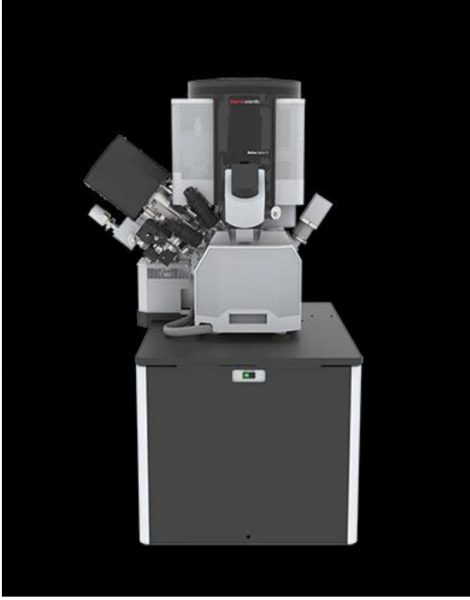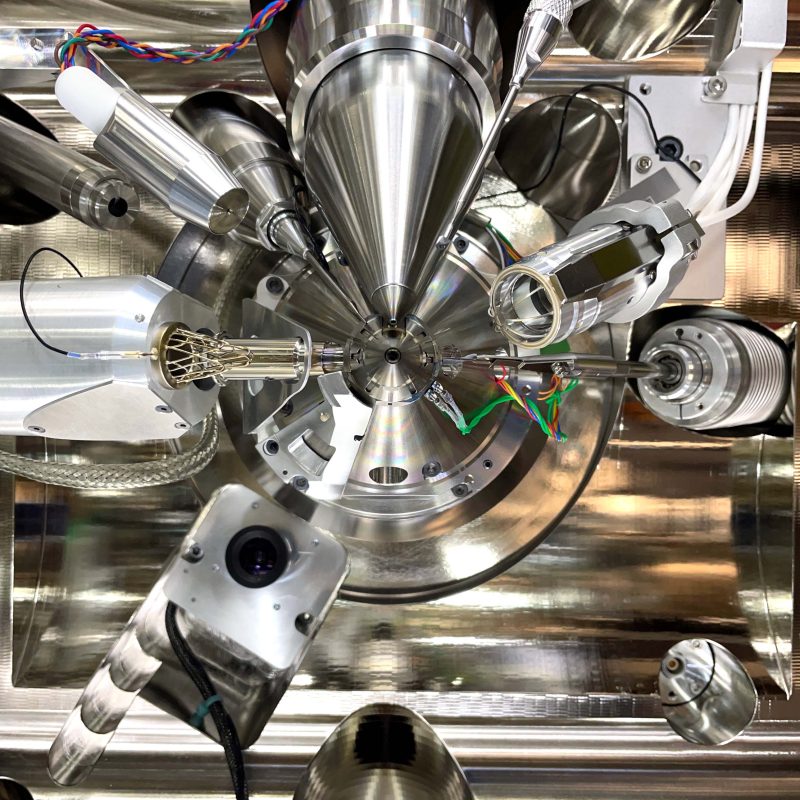Helios 5 Hydra DualBeam – Plasma Focused Ion Beam

The Helios Hydra G5 is very different than the Quanta 3D FIB. Instead of a gallium liquid metal ion source, the Hydra uses gas-based plasmas for milling and deposition. The advantages of using plasma is that beam currents can be much higher, leading to much faster mill rates, meaning one can spend less time milling features or mill much larger features. In fact, the Hydra enables milling on the millimeter length scale–a massive improvement over the Quanta! The Hydra is fully equipped with multiple deposition and etching chemistries, an extremely user friendly sample lift out manipulator, and state of the art EDS and EBSD attachments. These accessories enable the site specific study of structure, chemistry, and crystallography in 2D and 3D. The Hydra is a wonderful addition to our materials characterization toolset, and we’re excited for our users to explore its capabilities.
Questions? Contact Roberto Garcia at rgarcia@ncsu.edu.
Location: EBI 1046B
|
Equipment Specifications |
Helios 5 Hydra CX DualBeam |
|
|
Electron beam resolution |
· At optimum WD: o 0.7 nm at 1 kV o 1.0 nm at 500 V (ICD) · At coincident point: o 0.6 nm at 15 kV o 1.2 nm at 1 kV |
|
|
Electron beam parameter space |
· Electron beam current range: 0.8 pA to 100 nA at all accelerating voltages · Accelerating voltage range: 350 V – 30 kV · Landing energy range: 20* eV – 30 keV · Maximum horizontal field width: 2.3 mm at 4 mm WD |
|
|
Ion optics |
High-performance PFIB column with unique inductively coupled plasma (ICP) source supporting four ion species with fast switching capability · Ion species (primary ion beam): Xe, Ar, O, N · Switching time <10 minutes, only software operation · Ion beam current range: 1.5 pA to 2.5 µA · Accelerating voltage range: 500V – 30 kV · Maximum horizontal field width: 0.9 mm at beam coincidence point Xe Ion beam resolution at coincident point · <20 nm at 30 kV using preferred statistical method · <10 nm at 30 kV using selective edge method |
|
|
Chamber |
· E- and I-beam coincidence point at analytical WD (4 mm SEM) · Ports: 21 · Inside width: 379 mm · Integrated plasma cleaner |
|
|
Detectors |
· Elstar Column in-lens SE/BSE detector (TLD-SE, TLD-BSE) · Elstar Column in-column SE/BSE detector (ICD)* · Everhart-Thornley SE detector (ETD) · IR camera for viewing sample/column · High-performance in-chamber electron and ion detector (ICE) for secondary ions (SI) and electrons (SE) · In-chamber Nav-Cam Sample Navigation Camera* · Retractable low-voltage, high-contrast directional solid-state backscatter electron detector (DBS)* · Integrated beam current measurement
|
|
|
Stage and sample |
Flexible, five-axis motorized stage: · XY range: 110 mm · Z range: 65 mm · Rotation: 360° (endless) · Tilt range: -38° to +90° · XY repeatability: 3 μm · Max sample height: Clearance 85 mm to eucentric point · Max sample weight at 0° tilt: 5 kg (including sample holder) · Max sample size: 110 mm with full rotation (larger samples possible with limited rotation) · Compucentric rotation and tilt |
|
